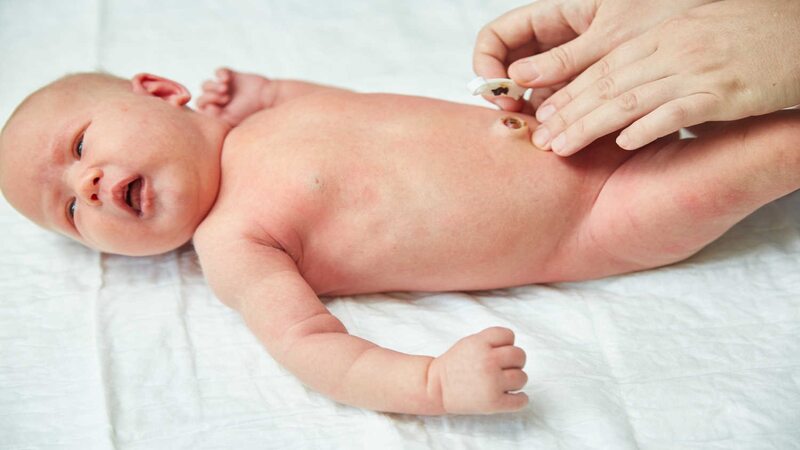
The occurrence of Omphalitis in newborn babies is rare in industrialized countries. Omphalitis remains the common cause of death in newborns in less developed regions. The threat of Omphalitis includes some risk factors, including Infected delivery, accidental home delivery, maternal chorioamnionitis and low birth weight among others.
Omphalitis primarily occurs during the span of the first few weeks of the baby’s birth. It is a bacterial infection of the tummy button and its surrounding tissues, mainly occurring in newborns. The effects of this disease can be very harmful. It can even lead to the continuous progress of the infection, and the death of an infant can also happen. Therefore, it is crucial to take Omphalitis in babies seriously.
What is Omphalitis?
Omphalitis is commonly termed the ‘Omphalitis of the Newborns’. Also, the medical term for bacterial infection or inflammation of the belly button is called Omphalitis. It occurs mainly after the baby’s birth, which is during the neonatal period.
Who is at Risk For Omphalitis?
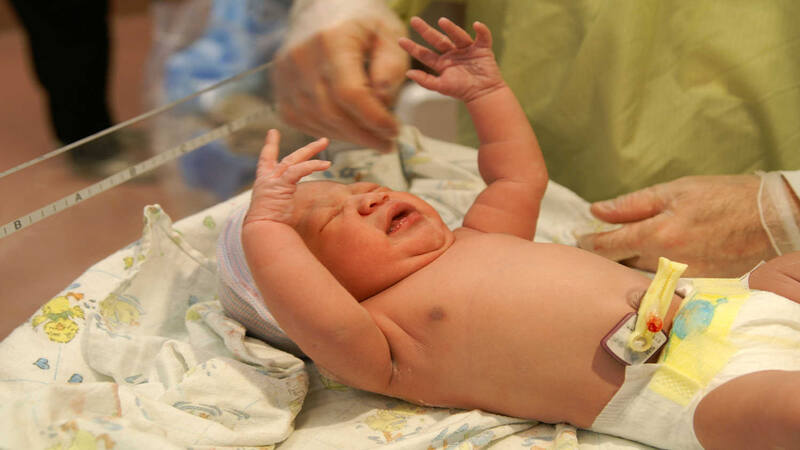
As mentioned earlier, omphalitis occurs during the early weeks after delivery, but the fact is that it is rarely seen beyond the neonatal period.
Research doesn’t suggest that babies can have a high risk of infection based on their sex, i.e., whether a boy or a girl. Rather there are major factors that can worsen the condition, and the babies may tend to suffer. The factors that determine who is at risk for omphalitis can be discussed as follows:
- The extended estrangement of the membranes is an important determining factor.
- Unhealthy cord care results in omphalitis.
- Infection of the mother can also infect the newborn baby.
- Umbilical catheterization.
- Extremely low birth weight of babies. Such babies are too prone to any type of infection.
- An unhealthy delivery process may cause omphalitis in babies.
- Chorioamnionitis (it is a bacterial infection of the amniotic membranes and fluid that surround and protect your baby)
- Birth of the baby before the expected delivery time. Preterm babies are at high risk.
- Delivery at home. Generally, proper health measures are not followed during delivery at home, leading to omphalitis in babies.
- Prolonged labor can also result in omphalitis in babies.
If your baby has been suffering from omphalitis, the indicative signs of the infections (such as fluid discharge and redness of the affected areas) will be visible within a few of the baby’s initial birth life. Just don’t ignore it or panic, Calling the doctor immediately will be the priority.
Causes of Omphalitis in Newborn Babies
The main cause behind the happening of omphalitis is bacterial infection at the time of delivery. When the umbilical cord is being cut at the birth time, but proper guidance is not followed or may occur after a few days after the baby’s birth at home. It happens mainly because of unhygienic practices.
The bacteria responsible for omphalitis are Streptococcus, Staphylococcus aureus, and Gram-negative bacteria. As mentioned above, omphalitis in babies happen because babies with neonatal tetanus are prone to get cord infections, especially due to the unhealthy delivery process and also unhygienic cord care practices.
But precautions can be taken to avoid omphalitis in babies. It can be controlled through thorough aftercare preventive measures post-delivery at home. The pediatrician’s guidance should be strictly followed at home. Only through these positive practices, omphalitis can be avoided.
[Read : Umbilical Cord Infections in Newborns]
Signs of Omphalitis in Newborn Babies
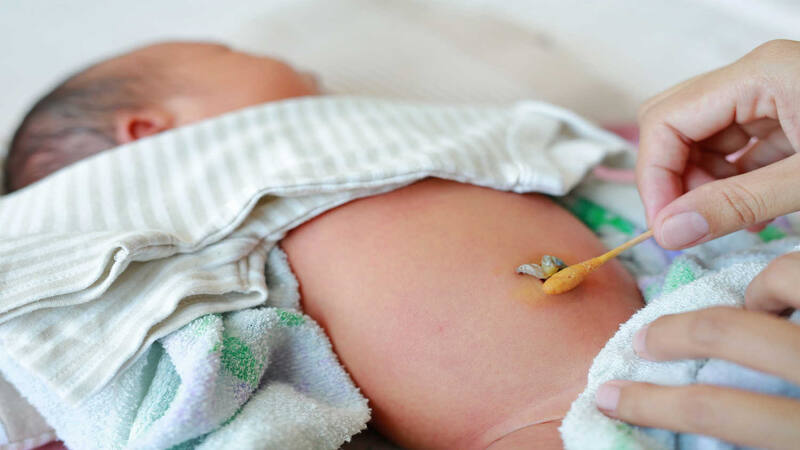
It is of utmost essential to keep a close eye on your little one’s belly button during the first few weeks of your baby’s existence. Below are signs and symptoms of omphalitis you need to keep watch for:
- Stomach swelling can occur.
- Skin color can change. It can turn red surrounding the belly button area.
- Pus or Liquid-filled lumps can be visible on or near the belly button area.
- The baby can suffer from a fever. Be very careful and don’t give medicine without a doctor’s advice.
- The umbilical cord stump area can bleed too.
- Foul-smelling discharge may occur from the affected area.
- Some of the other symptoms can include Prickliness, tiredness, and decreased activity
If any such symptoms are visible, then please consult the doctor as quickly as possible. If it is ignored, the effects can be too harsh to handle.
How is Omphalitis in Babies Diagnosed?
A doctor can simply diagnose omphalitis while checking the baby. The infection is quite visible, so it becomes easy for the doctor to diagnose. Also, the doctor can diagnose through the photograph. The clinical photograph is also a sufficient document for the doctor.
Treatment Options For Omphalitis in Babies
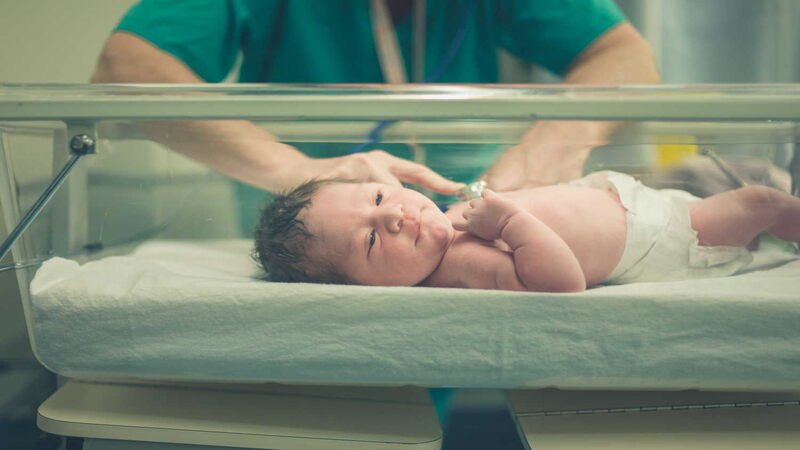
Staying alert and taking necessary steps quickly can prevent the little one from serious suffering.
- If it is observed (through the symptoms) that the baby has developed omphalitis-the umbilical cord infection, contact the pediatrician without delay.
- The treatment must be done under the doctor’s guidance.
- The standard treatment suggests that the baby should be hospitalized and stay under a doctor’s guidance for at least a few days.
- Constant monitoring of the little one should be done.
- The treatment includes controlling the required drug that fights against the said bacteria. But surgeries can be required for some critical cases.
How Can You Prevent Omphalitis in Newborn Babies?
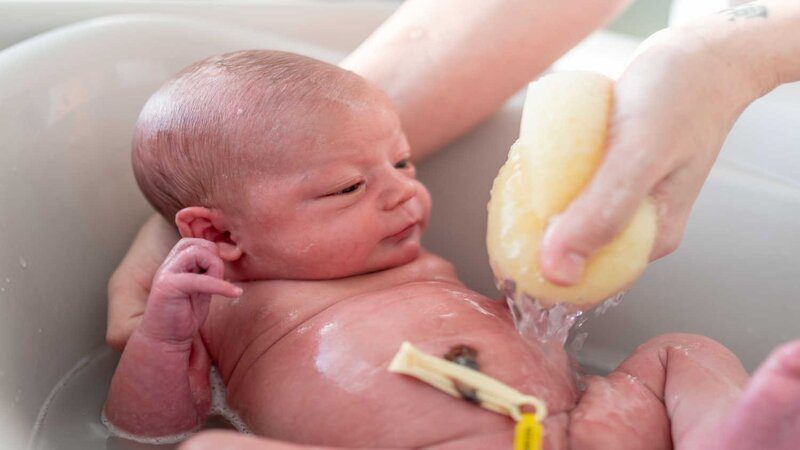
Here are a few ways to prevent omphalitis in babies.
- WHO recommends the topical application of chlorhexidine to the belly button area during the first week of life for newborn babies, especially at home.
- It is observed that at home, the hygienic conditions are poor and not maintained properly. This results in high neonatal mortality (>30 deaths per live birth). If you are planning for a home birth, it is vital that you take care to keep your home and room completely sterilized to prevent untoward infections.
Some necessary preventive measures can be applied to prevent omphalitis. The preventive strategies may include:
- Apply sponge baths to clean the baby until the stump falls off. Also, avoid sponging the area around the stump during bathing.
- If by chance the stump gets wet, then pat it with a soft dry towel.
- Use a clean clamp on the cord.
- Mothers must have immunization for tetanus during pregnancy.
- Lay the newborn on a clean surface and using sterile instruments to cut the cord.
- Avoid getting the stump wet as much as possible.
- Wash hands thoroughly with clean water and soap before delivery as well as before cutting and tying the cord.
Special Note: In modern times also, some cultures follow some traditional beliefs of applying ash, oil, or other substances to the umbilical cord. Stop practicing such actions. All of these will just increase the cause of infections and omphalitis in newborns.
[Read : Sponge Bath Your Baby]
When Should You Consider Seeing a Doctor?
You should be very careful in checking the signs and symptoms of omphalitis. Symptoms like clear liquid oozing from the belly button, drops of blood, and scabbing can be normal. But if you notice any signs of infection like an infected belly button or the baby suffering from continuous fever. Don’t ignore and consult the doctor immediately.
[Read : When Will My Baby’s Umbilical Stump Fall Off?]
FAQ’s
1. Can a Belly Button Infection Harm My Baby?
It is a matter of concern. Infections in newborns remain the leading cause of infant death worldwide. Doctors believe that umbilical cord infections (UCIs) are major reasons. But, in developed nations, serious complications due to UCIs are rarely observed. But, the baby should receive prompt treatment.
2. Is it Normal For a Newborn’s Belly Button to Ooze?
Yes, it is normal. It is very normal for the newborn’s belly button to ooze some clear secretions. It is also observed sometimes that the navel forms a coating. If it happens, let it heal up and fall off on its own.
3. How Do I Clean My Newborn’s Belly Button?
Follow the simple steps for cleaning a newborn’s belly button:
- Always keep the stump (belly button) dry. It should not remain wet for too long.
- Go for sponge baths. Sponge baths make it easier to keep the stump clean and dry.
- Let the stump fall off on its own.
- After the belly button area is completely healed, a normal bathing routine can be followed.
Always keep your baby’s belly button clean and dry. If you see any type of discharge, then just clean it with a piece of wet cotton and then let it dry quickly. If any abnormality is observed, consult the pediatrician without delay. Always be in touch with your pediatrician for any queries related to your baby’s umbilical cord. Keep your baby healthy and protected.
Read Also: Taking Care Of Umbilical Stump In Monsoon
